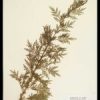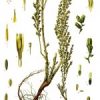Artemisia annua or Sweet Annie is a common type of oriental wormwood that is native to temperate Asia, but now naturalised throughout the world. It is also known as Oriental Wormwood, Chinese Wormwood, Annual Wormwood and less commonly, perhaps, as Sweet Sagewort
Chinese herbalists in ancient times used it to treat fever but it fell out of common use until it was rediscovered in 1970’s.
The tea and extracts from the Sweet Annie plant are believed,and in tests have proven, to have some antimalarial activity in primate models, and in 1972 the active ingredient, artemisinin (formerly referred to as arteannuin), was isolated and its chemical structure completely described.
Artemisinin itself is a sesquiterpene lactone with an endoperoxide bridge and has been produced semi-synthetically as an antimalarial drug. The efficacy of tea made from Sweet Annie in the treatment of malaria is known to be contentious. According to some authors, artemesinin is not soluble in water and the concentrations in these infusions are considered insufficient to treatment malaria. Other researchers have claimed that Sweet Annie contains a cocktail of anti-malarial substances, and insist that clinical trials be conducted to demonstrate scientifically that artemisia tea is effective in treating malaria.
This simpler use may be a cheaper alternative to commercial pharmaceuticals, and may enable health dispensaries in the tropics to be more self-reliant in their malaria treatment. In 2004, the Ethiopian Ministry of Health changed Ethiopia’s first line anti-malaria drug from Fansidar, a Sulfadoxine agent which has an average 36% treatment failure rate, to Coartem, a drug therapy containing artemesinin which is 100% effective when used correctly, despite a worldwide shortage at the time of the needed derivative from Artemisia annua.
There is also some considerable interest being shown by scientists in the Sweet Annie plant’s use in breast cancer and prostate cancer treatment.








